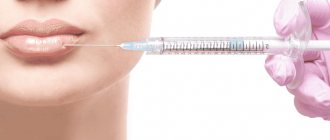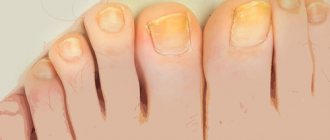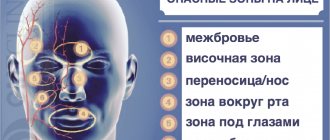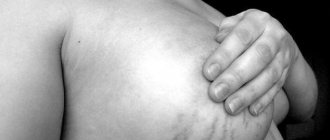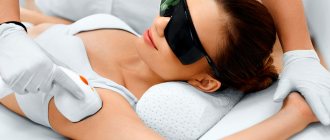home
/
Articles
/
How to get rid of a bruise after an injection
Intravenous or intramuscular administration of medicinal solutions is one of the most effective, safe and rational ways to deliver them to the body. Despite the fact that medicine has been actively using injections for centuries and the technique for performing them has been thoroughly developed, it is not always possible to avoid side effects during the procedure. Hematomas are one of the most common. This article will discuss the causes of bruises and ways to combat them.
Knowing how to get rid of unpleasant, painful and potentially dangerous bruises, you can avoid complications that are caused by unprofessional injections. But it is much more advisable to prevent their occurrence by entrusting the injection to qualified professionals. In this case, the likelihood of hematomas and bumps is minimized.
Nature of the phenomenon
It should be understood that any injection performed subcutaneously, intravenously or intramuscularly has a destructive effect on the skin, muscles, capillaries and other tissues of the body. But bruises, redness and bumps do not always appear after injections. Scientists explain their occurrence by the presence of the following factors (or a combination of them):
- Lack of sufficient experience from a specialist. Bruises may appear if the needle was not inserted perpendicular to the plane of the body or deeper than it should be, its diameter and size were chosen incorrectly, and the piston was pressed faster than necessary
- Specificity of the administered drug. There are medications that, when they enter the bloodstream, spasm the blood vessels at the injection site, which causes stagnation of blood flow and, as a result, the appearance of bumps and bruises
- Lack (or complete absence) of disinfection. Such an omission is unacceptable, because it can cause complications, the treatment of which will take much longer than the original disease
General information
The main cause of hematomas are bruises - closed injuries to soft tissues resulting from a blow or fall. A strong blow leads to rupture of the walls of small blood vessels, due to which blood begins to flow through the breakout sites into the subcutaneous tissue, soft tissues or body cavities. Hematomas form in different parts of the body - on the limbs, torso and even on the head. In addition to bruises, hematomas are caused by intense compression and stretching of tissues due to dislocations or fractures.
Small lesions, as a rule, do not require any treatment and resolve on their own within a few days. When large hematomas form, there is a risk of infection and the development of suppuration. Most often, hematomas form in representatives of younger age groups - children, adolescents and young people, who are characterized by high physical activity. Another “risk group” are people with increased fragility of the vascular wall, as well as with blood clotting disorders.
Why are bruises dangerous?
Bruising that turns into bruises, accompanied by lumps, can cause complications that are not so easy to get rid of. The most common of them will be discussed in more detail below:
- Abscess. In the medical literature, this phenomenon is characterized as an abscess that forms after an injection, accompanied by severe pain of a pulsating nature in the area of the bruise. Treatment is carried out by surgery or conservatively
- Allergic reactions. Expressed in the occurrence of severe itching at the injection site, swelling, sometimes a runny nose, shortness of breath, increased tearing and sweating, hematoma.
- Blood poisoning. This is the most serious thing that can happen after the injection. In this case, hospitalization and emergency treatment in a hospital setting, possibly a blood transfusion, will be required.
Types of damage
The faster a hematoma forms, the more difficult the recovery. Injuries of this type are divided into:
- lungs that develop within a day, accompanied by mild pain and not requiring special treatment;
- moderate severity, the appearance of which requires no more than 5-6 hours, accompanied by noticeable swelling and pain, worsening the motor function of the limb;
- severe, forming within 2 hours after a bruise, accompanied by dysfunction of the limb, acute pain and noticeable swelling.
Treatment of moderate and severe hematomas should be carried out under the supervision of a physician to eliminate possible negative consequences of injury.
In addition to the severity of the damage, there are other criteria for classifying hematomas:
- by depth of location - under the skin, under the mucous membrane, deep in the muscle tissue, under the fascia, etc.;
- according to the state of spilled blood - uncoagulated (fresh), coagulated and lysed (filled with old blood that is not capable of clotting);
- by the nature of blood distribution - diffuse (blood permeates the tissue and spreads quickly), cavitary (blood accumulates in the cavity between the tissues) and encysted (over time, the cavity filled with blood is surrounded by a “bag” of connective tissue);
- according to the condition of the vessel - pulsating (blood flows freely from the vessel and flows back) and non-pulsating (the rupture of the vessel is quickly sealed by a thrombus).
Almost always, hemorrhage poses a health hazard, so to eliminate its consequences, you need to seek medical help immediately after the injury.
Drug treatment
Traditional medicine has a wide range of methods and means that can help quickly get rid of bruises formed after incorrect injections. Here are the most common and effective:
- Local therapy. Involves the use of absorbable gels and creams
- The use of gels created to eliminate the consequences of varicose veins. They effectively constrict blood vessels and relieve inflammation
- Application of meshes. This is done using ordinary iodine. One of the simplest and most effective remedies that relieves swelling and removes bruises
- Lotions. To perform them, dimexide or magnesium sulfate pre-dissolved in hot water is used. A bandage or cotton wool is moistened in the solution and applied to the injection site
How to remove hematomas?
After establishing the nature and characteristics of the hematoma, treatment is prescribed in accordance with the information received:
- prescribe UHF procedures;
- a surgical opening is performed to remove accumulated clots and rinse the cavity;
- the patient is hospitalized in the surgical department for opening and drainage, followed by antibiotic therapy.
Recovery time depends on the extent of the lesion, the presence or absence of infection and other factors.
Folk remedies
Healers, herbalists and other representatives of alternative medicine also have a lot of opportunities to influence bruises to completely eliminate them. The most effective ones will be discussed in more detail below:
- Wraps. Cabbage leaves, previously crushed and pierced in several places, are applied to the injection sites.
- Warming up. Use calcined salt or heated stones. They are applied to hematomas and held, periodically replacing with hotter ones
- Compresses. Various ingredients are used to prepare them: honey, onions, egg yolks. All this is mixed with wheat flour and applied to the bruises
- Chatterboxes. They are prepared from a solution of acetic acid mixed with raw eggs. Rub bumps and bruises with this mixture 2-3 times a day until they disappear completely.
- Apitherapy. Propolis tincture has a disinfectant and anti-inflammatory effect. Its use helps get rid of bruises, hematomas and seals
Not all doctors recognize the effectiveness of alternative medicine in getting rid of hematomas after unprofessional or unsuccessful injections, but they also fully accept their use as an aid in the process of conservative therapy.
Price
| Surgeon consultation | 1 000,00 |
| Consultation with a cosmetologist + ultrasound | 3 000,00 |
| Magnetic laser therapy | 900,00 |
| Microcurrent therapy | 1 800,00 |
| Revixan | 4 500,00 |
| Removal of hyaluronic acid fillers using enzymes (Longidase) | 4 500,00 |
| Plasma therapy | 5 400,00 |
| Needle RF | |
| Laser resurfacing |
Biorevitalization and mesotherapy are low-traumatic procedures that have a minimum of contraindications. The injection cocktails used during the procedures include drugs that are similar to substances produced by the human body. Therefore, these drugs extremely rarely cause negative reactions. However, some people may still have individual intolerance to the components of the drug or anesthesia.
Side effects of injection procedures can manifest themselves in the form of swelling, bruising, bruising, redness or inflammation at the puncture site. And if the procedure technique is violated or the wrong dosage of the drug is chosen, more serious complications of mesotherapy or biorevitalization may occur.
Preventive measures
Any qualified doctor will confirm that it is easier to prevent disease, pathology and dysfunction than to treat it. To avoid unwanted complications in the form of bruises, bruises and lumps, you must adhere to the following rules:
- It is good to disinfect injection sites
- Use only sterile syringes
- Choose the most suitable place for injections
- Use medications whose expiration date is within the acceptable range
- Inject smoothly
- Remove the needle along the same path along which it was inserted, without unnecessary movements
If you adhere to the recommendations described above, the likelihood that bruises will appear is reduced to almost zero.
Examination methods
To diagnose hematomas, you need to contact a traumatologist. When the hemorrhage is localized deep in muscle tissue, joints or internal organs, a visual examination provides too little information for the doctor to objectively assess the severity of the lesion and the degree of danger of injury. In such situations, the patient is prescribed:
- Ultrasound of a damaged body part, organ or joint;
- X-ray of the damaged part of the body;
- CT or MRI;
- puncture (puncture with a special needle) of a joint or organ in which blood is believed to have accumulated.
Based on the examination results, the doctor prescribes appropriate procedures.
Prevention of complications
Many cytostatics damage veins, the aggressive cisplatin, anthracyclines and vinca alkaloids, as well as the relatively “mild” gemcitabine with fluorouracil, are especially zealous in initiating chemical phlebitis. Based on their effect on tissue, anthracyclines with vinca alkaloids are classified as blister agents, cisplatin is only an irritant, and gemcitabine is definitely not a blister agent. Nevertheless, any chemotherapy drug, and even more so a combination of cytostatics, can damage a vein, therefore, during intravenous administration, personnel must strictly follow the instructions for the duration and method of injection.
Physiotherapeutic procedures and acupuncture, phototherapy and infrared irradiation, and magnetic field stimulation help recovery.
In our Clinic, each patient undergoes a specific program of support for chemotherapy and recovery after treatment, focused on the characteristics of the body and tissue resistance.
Book a consultation 24 hours a day
+7+7+78
Bibliography:
- Russian clinical guidelines for the prevention and treatment of venous thromboembolic complications in cancer patients // M.: Planida; 2012
- Somonova O.V., Antukh E.A., Elizarova A.L., et al. /Practical recommendations for the prevention and treatment of thromboembolic complications in cancer patients // Malignant tumors: Practical recommendations RUSSCO #3s2; 2017 (vol. 7).
- Antithrombotic Therapy and Prevention of Thrombosis, 9th ed: American College of Chest Physicians Evidence-Based Clinical Practice Guidelines // Chest Am Coll Chest Phys.; 2012.
- Jones S., Holmes F., O'Shaughnessey J., et al. /Docetaxel with cyclophosphamide is associated with an overall survival benefit compared with doxorubicin and cyclophosphamide: 7-year follow-up of US Oncology Research trial 9735// JCO 2009; 27.
- International Society of Lymphology. The diagnosis and treatment of peripheral lymphedema: 2013 Consensus Document of the International Society of Lymphology // Lymphology; Mar 2013; 46(1).
- Khorana AA, Kuderer NM, Culakova E., et al./ Development and validation of a predictive model for chemotherapy-associated thrombosis// Blood 2008; 15.
Rehabilitation calendar after blepharoplasty by day
immediately after surgery
At the end of the operation, strips are glued to the eyelid area, and the patient is transferred to a ward, where ice is applied to the periorbital area to reduce swelling.
photo immediately after upper blepharoplasty surgery
As a rule, there is no pain after blepharoplasty. After 1-2 hours the patient is discharged for outpatient observation by a surgeon
first day
On the first day after surgery, the patient is bandaged. On days 1-2-3, swelling begins to increase. It is necessary to make cold lotions with antiseptics.
second day
On the 2nd day in the morning, you can take a single diuretic tablet (only as prescribed by your doctor) to reduce swelling. ъ
the third day
Swelling on day 3 is usually maximum. You are allowed to shower and wash your hair.
fourth day
On the 4th day, the swelling begins to gradually decrease, and the tension in the eyelids goes away.
5 day
During this period, the strips and stitches from the eyelids are removed.
6th day
After the stitches are removed, the strips are stuck on for a few more days.
7th day
By this time, the bruises are almost completely gone, the swelling is significantly reduced.
After a week, the most noticeable swelling in patients goes away, and you can already go to work, although it is optimal to stay at home for up to 2 weeks.
9th day
At this time the strips are completely removed
The swelling is significantly reduced. The suture line is reddish. You can start using cosmetics.
2 weeks
Even at this time, the redness begins to gradually decrease, the swelling continues to decrease.
in three weeks
There is no longer any visible swelling and bruising, patients come to the clinic for routine dressing changes, and they can slowly resume light sports activities.
a month later
You can return to full physical activity.
2, 3, 6 and 12 months
Scheduled control inspections are carried out. They assess the condition of the scars.

